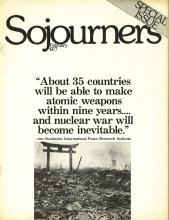The three aspects of the strategic nuclear triad are land, sea and air. The land leg today consists of 1,054 inter-continental ballistic missiles in underground silos, over half of which are the Minuteman III vehicles, each equipped with three 200-kiloton re-entry bodies that can be directed against separate targets.
The air wing consists of 496 intercontinental B-52 bombers. Over two hundred of these aircraft are the later “G” and “H” models which comprise the backbone of the Strategic Air Command. Each bomber can be equipped with up to twenty nuclear-tipped missiles to launch against ground targets.
The sea leg is presently comprised of ten Polaris and 31 Poseidon submarines, each carrying sixteen ballistic missiles. The missiles on the older Polaris submarines are each loaded with three 200-kiloton bombs. Poseidon boats, of course, carry Poseidon missiles which are equipped with up to 14 individually-targeted reentry bodies. One Poseidon submarine has the potential to destroy 160 cities with bombs having at least twice the explosive energy that was unleashed against Hiroshima.
This vast array of power does not satisfy the American military. Their thirst for bigger and better weapons is supported by a significant number of large business firms which reap lavish profits from weapons contracts. Virtually every leg of the strategic triad is undergoing modernization.
Studies on mobile missiles, called Missile-X or M-X, have been underway for many years but have intensified recently. The Pentagon wants to start replacing land-basal intercontinental missiles with mobile Missile-X by the mid-1980s. They claim that silo-based weapons will be vulnerable by then. Missile-X will be either air-mobile or land-mobile, maybe both.
Read the Full Article

